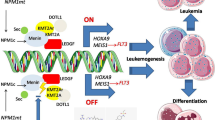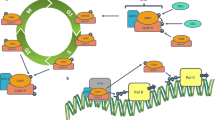Abstract
Purpose
Amongst the epigenetically targeted therapies, targeting of the histone deacetylases (HDACs) has yielded numerous drugs for clinical use in hematological malignancies, but none as yet for acute lymphocytic leukemia (ALL). Single agent activity of HDAC inhibitors (HDACi) has been elusive in ALL, and has prompted study of combinatorial strategies. Because several HDACi raise levels of intracellular oxidative stress, we evaluated combinations of two structurally distinct HDACi with the redox active compound adaphostin in ALL.
Methods
The HDACi vorinostat and entinostat were tested in combination with adaphostin in human ALL cell lines. DNA fragmentation, caspase activation, mitochondrial disruption and levels of intracellular peroxides, superoxide and glutathione were measured in cells treated with the HDACi/adaphostin combinations. Antioxidant blockade of cell death induction and gene expression profiling of cells treated with vorinostat/adaphostin versus entinostat/adaphostin combinations were evaluated.
Results
Both combinations synergistically induced apoptotic DNA fragmentation, which was preceded by an increase in superoxide levels, a reduction in mitochondrial membrane potential, and an increase in caspase-9 activation. The antioxidant N-acetylcysteine (NAC) blocked superoxide generation and prevented reduction of mitochondrial membrane potential. NAC decreased DNA fragmentation and caspase activity in cells treated with adaphostin and vorinostat, but not in those treated with adaphostin and entinostat. Gene expression arrays revealed differential regulation of several redox genes prior to cell death induction.
Conclusions
A redox modulatory agent, adaphostin, enhances efficacy of two HDACi, vorinostat or entinostat, but via different mechanisms indicating a point of divergence in the mechanisms of synergy between the two distinct HDACi and adaphostin.







Similar content being viewed by others
References
West AC, Johnstone RW (2014) New and emerging HDAC inhibitors for cancer treatment. J Clin Invest124(1):30–39
Masetti R et al (2011) The role of HDACs inhibitors in childhood and adolescence acute leukemias. J Biomed Biotechnol2011:148046
Dasmahapatra G et al (2010) The pan-HDAC inhibitor vorinostat potentiates the activity of the proteasome inhibitor carfilzomib in human DLBCL cells in vitro and in vivo. Blood. 115(22): 4478–4487
Mann BS et al (2007) FDA approval summary: vorinostat for treatment of advanced primary cutaneous T-cell lymphoma. Oncologist12(10):1247–1252
Ryan QC et al (2005) Phase I and pharmacokinetic study of MS-275, a histone deacetylase inhibitor, in patients with advanced and refractory solid tumors or lymphoma. J Clin Oncol23(17):3912–3922
Rosato RR, Almenara JA, Grant S (2003) The histone deacetylase inhibitor MS-275 promotes differentiation or apoptosis in human leukemia cells through a process regulated by generation of reactive oxygen species and induction of p21CIP1/WAF1 1. Cancer Res63(13):3637–3645
Gojo I et al (2007) Phase 1 and pharmacologic study of MS-275, a histone deacetylase inhibitor, in adults with refractory and relapsed acute leukemias. Blood109(7):2781–2790
Falkenberg KJ, Johnstone RW (2014) Histone deacetylases and their inhibitors in cancer, neurological diseases and immune disorders. Nat Rev Drug Discov13(9):673–691
Ceccacci E, Minucci S (2016) Inhibition of histone deacetylases in cancer therapy: lessons from leukaemia. Br J Cancer114(6):605–711
Gao S et al (2008) Potentiation of reactive oxygen species is a marker for synergistic cytotoxicity of MS-275 and 5-azacytidine in leukemic cells. Leuk Res32(5):771–780
Chung CG, Poligone B (2015) Cutaneous T cell lymphoma: an update on pathogenesis and systemic therapy. Curr Hematol Malig Rep10(4):468 – 76
Thurn KT et al (2011) Rational therapeutic combinations with histone deacetylase inhibitors for the treatment of cancer. Future Oncol7(2):263–283
Kirschbaum M et al (2014) A phase 1 clinical trial of vorinostat in combination with decitabine in patients with acute myeloid leukaemia or myelodysplastic syndrome. Br J Haematol167(2):185–193
Zhou W et al (2015) Proteasome inhibitor MG-132 enhances histone deacetylase inhibitor SAHA-induced cell death of chronic myeloid leukemia cells by an ROS-mediated mechanism and downregulation of the Bcr-Abl fusion protein. Oncol Lett10(5):2899–2904
Yaseen A et al (2012) Resveratrol sensitizes acute myelogenous leukemia cells to histone deacetylase inhibitors through reactive oxygen species-mediated activation of the extrinsic apoptotic pathway. Mol Pharmacol82(6):1030–1041
Nguyen T et al (2011) HDAC inhibitors potentiate the activity of the BCR/ABL kinase inhibitor KW-2449 in imatinib-sensitive or -resistant BCR/ABL + leukemia cells in vitro and in vivo. Clin Cancer Res17(10):3219–3232
Shanafelt TD et al (2005) Adaphostin-induced apoptosis in CLL B cells is associated with induction of oxidative stress and exhibits synergy with fludarabine. Blood105(5):2099–2106
Chandra J et al (2003) Involvement of reactive oxygen species in adaphostin-induced cytotoxicity in human leukemia cells. Blood102(13):4512–4519
Le SB et al (2007) Inhibition of mitochondrial respiration as a source of adaphostin-induced reactive oxygen species and cytotoxicity. J Biol Chem282(12):8860–8872
Fer ND, Shoemaker RH, Monks A (2010) Adaphostin toxicity in a sensitive non-small cell lung cancer model is mediated through Nrf2 signaling and heme oxygenase 1. J Exp Clin Cancer Res29:91
Hose C et al (2005) Transcriptional profiling identifies altered intracellular labile iron homeostasis as a contributing factor to the toxicity of adaphostin: decreased vascular endothelial growth factor secretion is independent of hypoxia-inducible factor-1 regulation. Clin Cancer Res11(17):6370–6381
Chou TC, Talalay P (1984) Quantitative analysis of dose–effect relationships: the combined effects of multiple drugs or enzyme inhibitors. Adv Enzym Regul22:27–55
Lucas DM et al (2004) The histone deacetylase inhibitor MS-275 induces caspase-dependent apoptosis in B-cell chronic lymphocytic leukemia cells. Leukemia18(7):1207–1214
Long J et al (2007) Adaphostin cytoxicity in glioblastoma cells is ROS-dependent and is accompanied by upregulation of heme oxygenase-1. Cancer Chemother Pharmacol59(4):527–535
Bots M, Johnstone RW (2009) Rational combinations using HDAC inhibitors. Clin Cancer Res Off J Am Assoc Cancer Res15(12):3970–3977
Rosato RR et al (2008) Role of histone deacetylase inhibitor-induced reactive oxygen species and DNA damage in LAQ-824/fludarabine antileukemic interactions. Mol Cancer Ther7(10):3285–3297
Ruefli AA et al (2001) The histone deacetylase inhibitor and chemotherapeutic agent suberoylanilide hydroxamic acid (SAHA) induces a cell-death pathway characterized by cleavage of Bid and production of reactive oxygen species. Proc Natl Acad Sci USA98(19):10833–10838
Zhang F et al (2009) Sensitization to gamma-irradiation-induced cell cycle arrest and apoptosis by the histone deacetylase inhibitor trichostatin A in non-small cell lung cancer (NSCLC) cells. Cancer Biol Ther8(9):823 – 31
Rivera SP et al (2005) Identification of aldehyde oxidase 1 and aldehyde oxidase homologue 1 as dioxin-inducible genes. Toxicology207(3):401–409
Wright RM et al (1997) Molecular cloning, refined chromosomal mapping and structural analysis of the human gene encoding aldehyde oxidase (AOX1), a candidate for the ALS2 gene. Redox Rep3(3):135 – 44
Stavrinou P et al (2015) Expression profile of genes related to drug metabolism in human brain tumors. PLoS One10(11):e0143285
Park JS et al (2016) Intraoperative diagnosis support tool for serous ovarian tumors based on microarray data using multicategory machine learning. Int J Gynecol Cancer26(1):104 – 13
Varisli L (2013) Identification of new genes downregulated in prostate cancer and investigation of their effects on prognosis. Genet Test Mol Biomark17(7):562–566
Geybels MS et al (2015) Epigenomic profiling of DNA methylation in paired prostate cancer versus adjacent benign tissue. Prostate75(16):1941–1950
Acknowledgements
We are grateful to Phillip Knouse for providing technical support for AOX1 transcript detection.
Funding
Support from NIH (CA115811-S1; P30CA016672 and P50 CA100632) is gratefully acknowledged.
Author information
Authors and Affiliations
Corresponding author
Ethics declarations
Conflict of interest
All authors declare that he/she have no conflict of interest.
Ethical approval
This article does not contain any studies with human participants or animals performed by any of the authors.
Rights and permissions
About this article
Cite this article
Rivera-Del Valle, N., Cheng, T., Irwin, M.E. et al. Combinatorial effects of histone deacetylase inhibitors (HDACi), vorinostat and entinostat, and adaphostin are characterized by distinct redox alterations. Cancer Chemother Pharmacol 81, 483–495 (2018). https://doi.org/10.1007/s00280-017-3509-0
Received:
Accepted:
Published:
Issue Date:
DOI: https://doi.org/10.1007/s00280-017-3509-0




